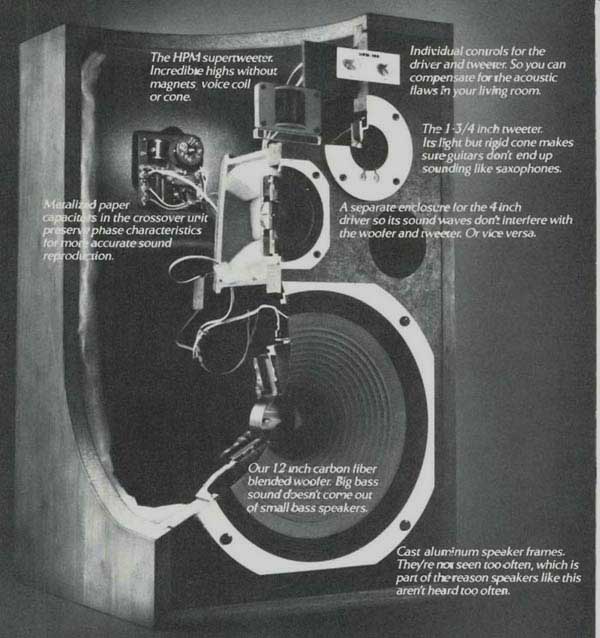WHEN YOU BUILD A SPEAKER TO SOUND GREAT ON EVERY PART OF THE MUSIC, YOU CAN'T CUT CORNERS ON ANY PART OF THE SPEAKER.
A single HPM-100 weighs almost 60 pounds.
The fact it weighs more than a Large Advent speaker, Bose 901 or JBL L100 is not an accident.
Our speaker frames are made of heavy cast aluminum instead of the usual stamped metal, so you hear only the speakers vibrating and never their frames.
Our magnets are oversize to spare your ears needless distortion.
And our cabinet is made out of special compressed wood that's denser and heavier than ordinary wood. So the sound is forced out of the cabinet instead of being absorbed by it.
Of course, not everything that adds to the sound of an HPM-100 also adds to its weight.
Our supertweeter uses nothing but a piece of High Polymer Molecular film to produce incredibly clear and crisp high frequencies.
Our midrange driver and tweeter have cones that are light enough to give sharp response, but rigid enough not to distort.
And our 12 inch woofer has a long throw voice coil and unique carbon fiber blend cone (instead of the more typical cardboard cone)
that work to produce the kind of realistic bass you not only hear, but feel.
Naturally, we could go on. About our 12-1/2 feet of damping material. Or about the aluminum screws that keep our speakers from falling out. They're ordinarily used to keep airplanes from falling apart.
But we figure at this point you'd rather hear our speakers in person than hear any more about them from us.

- The HPA1 supertweeter. Incredible highs without magnets, voice coil, or cone.
- Metalized paper capacitor in the crossover unit preserve phase characteristics for accurate sound reproduction.
- Individual controls for the driver and tweeter. So you can compensate for the acoustic flaws ¡n your living room.
- The 1-3/4 inch tweeter. Its light but rigid cone makes sure guitars don't end up sounding like saxophones.
- A separate enclosure for the 4 inch driver so its sound waves don't interfere with the woofer and tweeter. Or vice versa.
- Our 12 inch carbon fiber blended woofer. Big bass sound doesn't come out of small bass speakers.
- Cast aluminum speaker frames. They're nor seen too often, which is part of the reason speakers like this aren't heard too often.
PIONEER’s HPM-100 -- The all-around great speaker.
(
Also see:
Pioneer series R speakers (ad, Apr. 1973)
Pioneer HPM speaker systems (ad, Aug. 1979)
Pioneer Elite TZ Series reference loudspeakers (Apr. 1989)
= = = =